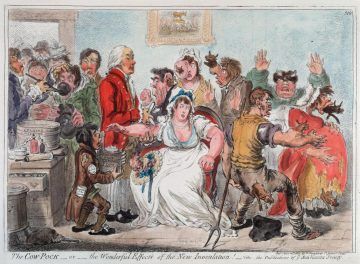Gareth Williams in MIL:
 In September 1798 a self-published book with an outlandish premise was about to change the world. At first sight, “An Inquiry into the Cowpox” looked more like a piece of vanity publishing than one of the greatest landmarks in the history of medicine. Its author, a doctor called Edward Jenner, was largely unknown outside rural Gloucestershire. In a 75-page illustrated manual, Jenner explained how people could protect themselves from smallpox – a horrific brute of a disease that killed one person in 12 and left many survivors scarred for life – by inoculating themselves with cowpox, an obscure disease that affected cattle. This extraordinary process was to be known as vaccination, from the Latin for cow.
In September 1798 a self-published book with an outlandish premise was about to change the world. At first sight, “An Inquiry into the Cowpox” looked more like a piece of vanity publishing than one of the greatest landmarks in the history of medicine. Its author, a doctor called Edward Jenner, was largely unknown outside rural Gloucestershire. In a 75-page illustrated manual, Jenner explained how people could protect themselves from smallpox – a horrific brute of a disease that killed one person in 12 and left many survivors scarred for life – by inoculating themselves with cowpox, an obscure disease that affected cattle. This extraordinary process was to be known as vaccination, from the Latin for cow.
The “Inquiry” was an instant sensation. Within a few years, vaccination became mainstream medical practice in Britain, Europe and North America, while the King of Spain sent it as a “divine gift” to all the Spanish colonies. By the time Jenner died in 1823, millions had come to regard him as a hero. His admirers included Native Americans, the Empress of Russia (who sent him a diamond ring out of gratitude), and Napoleon, who “could refuse this man nothing” even though France and England were at war. In 1881 Louis Pasteur proposed that the term “vaccination” should be used for any kind of inoculation.
But not everyone thought Jenner was a saint. In 1858 Prince Albert unveiled a statue to Jenner in Trafalgar Square, amid much pomp and circumstance. There was such an outcry that two years later the statue was carted away to a lower-key resting place in Kensington Gardens. Jenner’s earliest and most vocal opponents had been men of the church, who reasoned that smallpox was a God-given fact of life and death. If the Almighty had decided that someone would be smitten by smallpox, then any attempt to subvert this divine intention was blasphemy.
More here.
